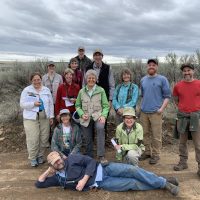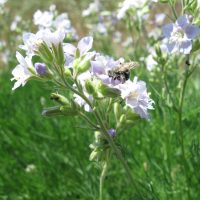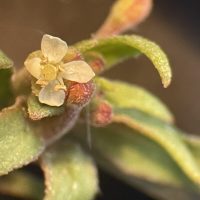Partner Spotlight: Sienna Wessel
Sienna Wessel is the first-ever second botanist at the Washington Natural Heritage Program (WNHP), bringing with her experience working for multiple land management agencies across the Great Plains and Rocky Mountains. Hailing from the Midwest, Sienna’s botanical journey began in the tallgrass prairie, where she developed a deep desire to protect plant biodiversity within the tiny remaining refugia of this once vast ecosystem.
Read moreMonitoring Weekend
The weekend of July 12th – 14th found 15 Rare Care volunteers and assorted partners on Table Mountain in the Cle Elum Ranger District for the annual Monitoring Weekend. We conducted 21 surveys and successfully located the target plant on 16 of them, with all of the teams participating in at least one success and one new discovery. Thank you to all of our fabulous volunteers!
Read moreNotes from the Field
It is nearing the end of my summer internship with Rare Care, stationed at Mount Rainier National Park, and I am excited to share what we found! The internship opportunity sprung from a collaboration between Rare Care and the National Park Service to confirm and improve the accuracy of rare plant records within Mount Rainier National Park’s boundaries. For the Park Service, this work will provide vital spatial information about rare plants to inform management decisions.
Read moreRare Care Plant Profile
An endemic plant found only in Benton County of Washington State, Umtanum desert buckwheat (Eriogonum codium) is a long-lived perennial adapted to grow in an arid landscape. This compact, tufted plant forms a low-branching woody stem from a stout taproot and spreads 2-9 dm laterally but rarely reaching a height much higher than 8 inches. Leaves are basal, oblanceolate to elliptic in shape, and only 6-12 mm long x 3-6 mm wide.
Read moreTesting Direct Seeding for an Arid Endemic
As home gardeners know, sowing seeds is much cheaper than buying plant plugs. In 2019, Rare Care started an experiment to test if direct seeding of White Bluffs bladderpod (Physaria douglasii ssp. tuplashensis) could be an efficient method to establish new populations.
Establishing a new population of White Bluffs bladderpod would help meet the Recovery objectives for this threatened species. It is a single-site endemic found only on a narrow, 17-km stretch of the White Bluffs on the east side of the Columbia River.
Restoring Habitat for Species Recovery
Five years ago, Rare Care established vegetation plots in a population of Wenatchee Mountains checker-mallow (Sidalcea oregana var. calva) to evaluate how to control the spread of shrubs and non-native grasses in its habitat. This federally endangered plant grows in flat, seasonally wet meadows in Ponderosa pine, Douglas fir, or aspen forest openings, and is known from only two large and two very small extant populations in the Wenatchee Mountains.
Read moreNotes from the Field
Rare Care volunteers are known for going on some pretty extreme adventures each year to search for rare plants, and the 2023 monitoring season was no exception. From paddling down rivers to trekking up mountains and cliffsides, it doesn’t seem like there’s much that can stop our volunteers, except maybe the occasional rattlesnake encounter!
Volunteers Carol Mack, John Stuart and two friends took their canoes 10 miles up the Pend Oreille River to search the shoreline for lesser-bladder milk vetch (Astragalus microcystis).
Rare Care Volunteer Spotlights

Each year Rare Care recognizes volunteers for their outstanding contributions.
Mickie Chamness trained back in 2005 and has completed 17 monitoring assignments and contributed over 140 volunteer hours. We really appreciate Mickie’s contributions to the botany surveys at Two Steppe and Marcellus Shrub Steppe NAPs, and her monitoring reports each year are excellent. We are so lucky to have her on the monitoring team for so long!
Plant Spotlight: Washington Polemonium

Washington polemonium (Polemonium pectinatum) is a distinctive perennial Washington endemic. As the Latin name implies, its leaves are pectinate, a term that describes its feathery, pinnately compound leaves that have 11-17 narrow leaflets. These unique leaves make this species stand out amongst other members of the genus in Washington. In mid-May to early June, its branched inflorescence blooms with light blue to lavender flowers that sometimes have faint maroon veins.
Read moreVolunteers Make a Great Find

In early June, Rare Care volunteers Mickie Chamness and Janelle Downs stumbled upon a population of small evening primrose (Eremothera minor), a state sensitive plant species. It was actually on their way to another primrose monitoring assignment that they noticed the small population of 30 plants in the tracks of the dirt road they were hiking. This population of small evening primrose is one that Rare Care had previously searched for three times in that exact location, but never found any.
Read more